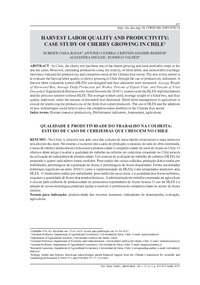Harvest labor quality and productivity: Case study of cherry growing in Chile
Autor
Adasme-Berríos, Cristian
Jara-Rojas, Roberto
Guerra, Antonio
Engler, Alejandra
Valdés, Rodrigo
Fecha
2015Resumen
In Chile, the cherry tree has been one of the fastest growing and most profitable crops in the last ten years. However, increasing production costs, the scarcity of hired labor, and unfavorable exchange rates have reduced the productivity and competitiveness of the Chilean fruit sector. The aim of this article is to evaluate the harvest labor quality in cherry growing in Chile through the use of productivity indicators. A harvest labor evaluation system (HLES) was designed and four indicators were measured: Average Weight of Harvested Box, Average Daily Production per Worker, Percent of Export Fruit, and Percent of Fruit Discarded. Significant differences were found between the 2010/11 season (with the HLES implementation)
and the previous seasons without HLES. The average worker yield, average weight of a filled box, and fruit quality improved, while the amount of discarded fruit decreased. Hired labor management in agriculture is crucial for improving the productivity of the fresh fruit export producers. The use of HLES and the adoption of new technologies could help to solve the competitiveness problem in the Chilean fruit sector.
Fuente
Revista Brasileira de Fruticultura, 37(2), 423-431Identificador DOI
dx.doi.org/10.1590/0100-2945-070/14Colecciones
La publicación tiene asociados los siguientes ficheros de licencia:


